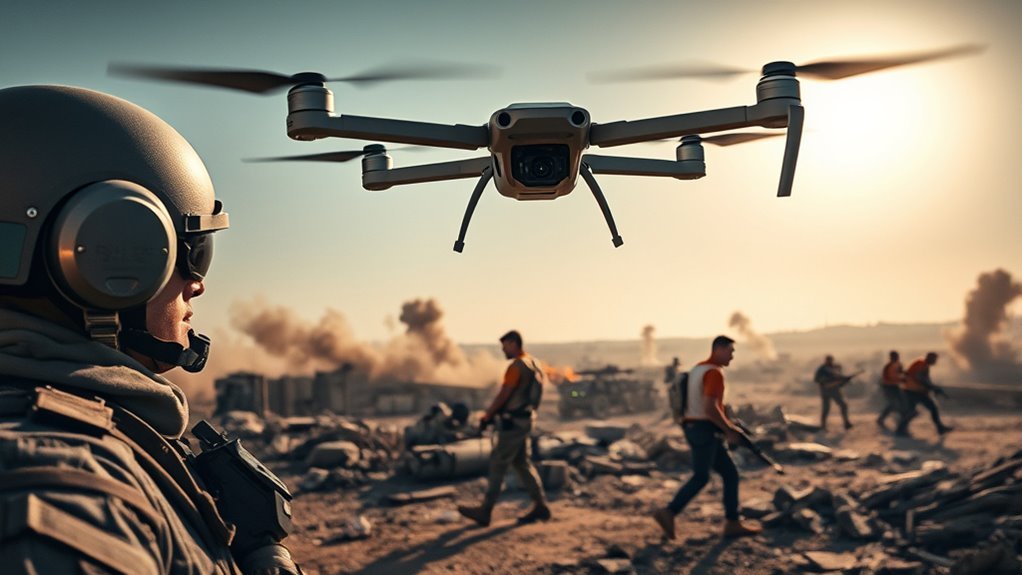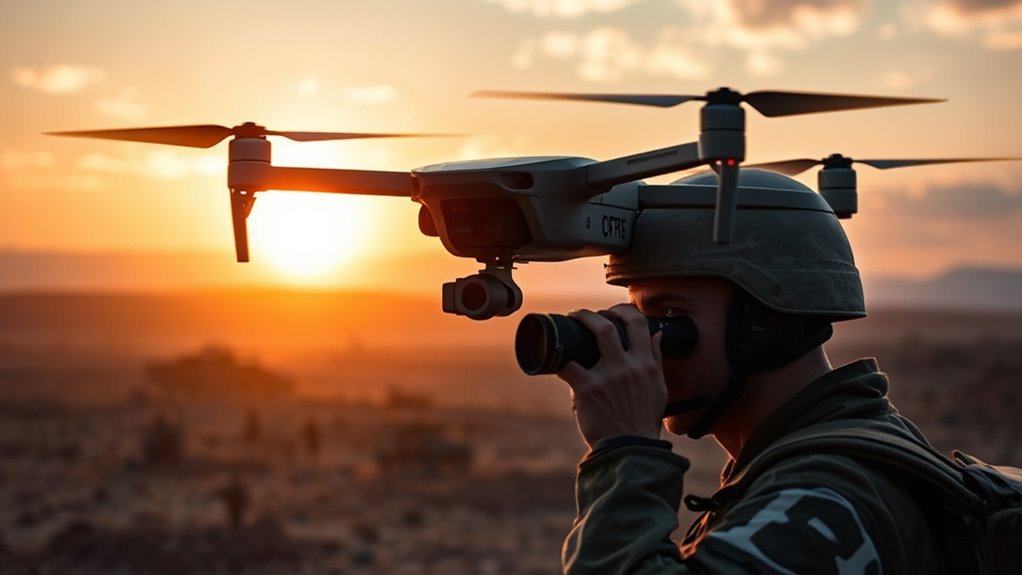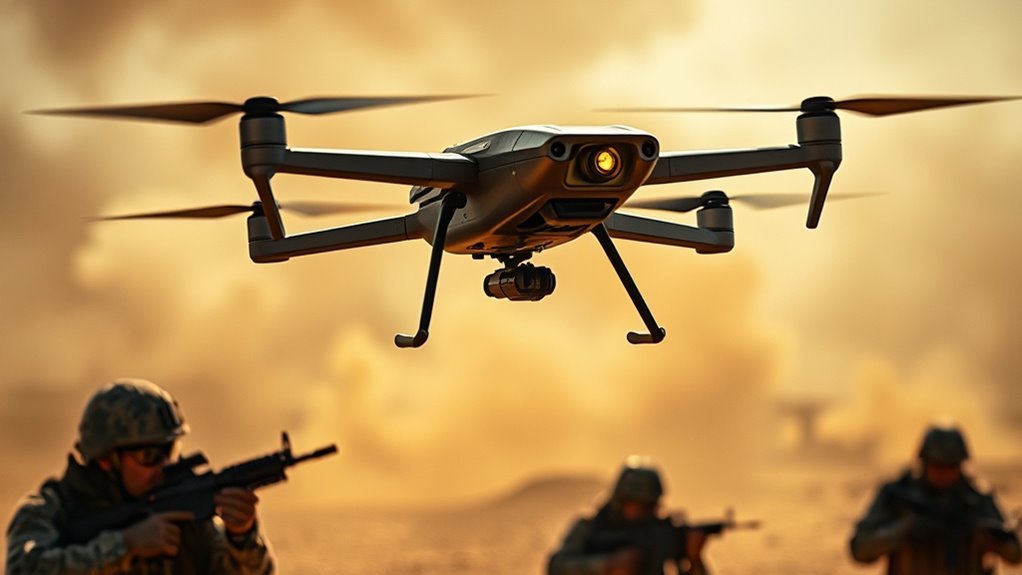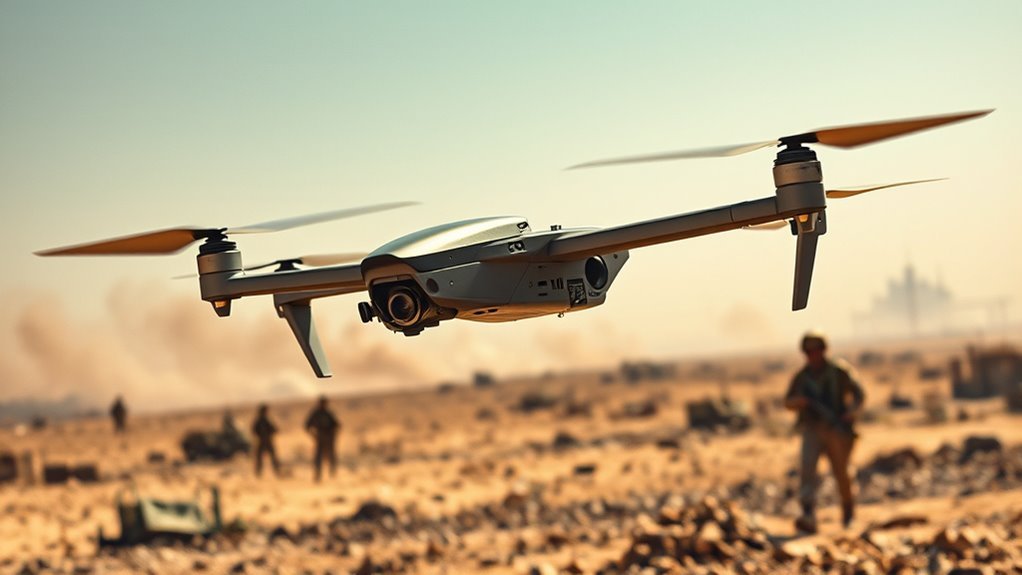The Mosquito Drone plays an essential role in modern warfare by enhancing battlefield intelligence and tactical operations. It features high-resolution cameras and thermal imaging for real-time intelligence gathering, even in low visibility. Its compact design and advanced maneuverability allow for stealthy reconnaissance and quick adjustments during missions. Additionally, its integration into military strategies aids in both offensive strikes and situational awareness. Discover more about its capabilities and applications to fully understand its impact on combat scenarios.
Overview of the Mosquito Drone

While the concept of drones in warfare isn’t new, the Mosquito Drone represents a significant advancement in unmanned aerial vehicle (UAV) technology. You’ll find that its design reflects the latest military advancements in drone technology, emphasizing agility and stealth. This drone’s compact size allows for deployment in various environments, making it an asset in tactical operations. With enhanced surveillance capabilities, it provides real-time intelligence without compromising safety. The Mosquito Drone’s integration into military strategies signifies a shift towards more sophisticated aerial assets, enabling forces to execute missions with greater precision. As you explore its capabilities, it becomes clear that this drone not only enhances operational effectiveness but also highlights the ongoing evolution of warfare technology aimed at protecting freedoms and reducing risks.
Key Features and Specifications

The Mosquito Drone’s surveillance capabilities enable real-time monitoring of enemy positions with high-resolution cameras and advanced sensor technology. In addition to its reconnaissance features, it also incorporates offensive functions, allowing for targeted strikes against identified threats. Understanding these key specifications is essential for evaluating its overall effectiveness in a warzone scenario.
Surveillance Capabilities
Although many drones are designed for various applications, the mosquito drone stands out due to its advanced surveillance capabilities. It provides essential tools for real-time monitoring and data analysis, enhancing situational awareness in the field. Here are some key features:
- High-Resolution Cameras: Capture detailed imagery for precise assessments.
- Thermal Imaging: Identify targets and movements in low-visibility conditions.
- Extended Flight Time: Remain airborne longer for thorough surveillance missions.
- Automated Data Processing: Analyze gathered information efficiently, allowing for faster decision-making.
These features collectively guarantee that you have a strategic edge in dynamic environments, enabling you to monitor areas effectively and respond promptly to threats. The mosquito drone’s capabilities are vital for maintaining operational freedom and tactical advantage.
Offensive Functions
Equipped with a suite of offensive functions, the mosquito drone is designed to engage targets with precision and efficiency. It leverages advanced technology to conduct tactical strikes, allowing for rapid deployment and minimal collateral damage. The drone’s lightweight design enhances maneuverability, enabling it to navigate complex environments and execute strikes swiftly. Additionally, its aerial reconnaissance capabilities guarantee real-time intelligence gathering, providing operators with critical data on enemy positions and movements. This dual functionality enhances situational awareness while facilitating effective engagement strategies. As you operate the mosquito drone, you’ll appreciate its seamless integration of offensive capabilities with reconnaissance, empowering you to make informed decisions in high-stakes scenarios. The balance of aggression and intelligence is key to its operational success.
How the Mosquito Drone Operates

The Mosquito Drone operates through advanced flight mechanics that allow for agile maneuverability in complex environments. Its surveillance capabilities enable real-time data collection, providing critical insights to operators on the ground. Understanding these functions is essential for maximizing the drone’s effectiveness in a warzone setting.
Flight Mechanics Explained
As the Mosquito drone navigates complex environments, its flight mechanics rely on advanced aerodynamic principles and precise control algorithms. You’ll appreciate how these elements contribute to drone navigation and flight stability. Key features include:
- Dynamic Stability: Maintains balance during maneuvers, enhancing operational efficiency.
- Adaptive Control Systems: Automatically adjusts to environmental changes, ensuring precise flight paths.
- High Maneuverability: Capable of quick direction changes, allowing for evasive actions in combat scenarios.
- Sensor Integration: Utilizes real-time data from onboard sensors to optimize performance and maintain stability.
These aspects work in harmony, enabling the Mosquito drone to execute complex missions while adapting to the unpredictable nature of war zones, ultimately supporting your tactical objectives.
Surveillance Capabilities Overview
With advanced flight mechanics enhancing its navigation and stability, the Mosquito drone’s surveillance capabilities are designed to provide real-time intelligence in dynamic environments. Utilizing cutting-edge drone technology, it can swiftly maneuver through various terrains, ensuring thorough battlefield surveillance. Equipped with high-resolution cameras and sensors, the Mosquito captures detailed imagery and data, which can be analyzed to assess enemy movements and positions. Its ability to transmit information instantaneously allows you to make informed decisions quickly, enhancing your operational effectiveness. Additionally, the drone’s stealth features minimize detection, enabling it to gather intelligence undetected. By integrating these advanced capabilities, the Mosquito drone proves to be an invaluable asset, offering you a strategic advantage in any conflict scenario.
Advantages of Using the Mosquito Drone
Five key advantages make the Mosquito Drone a valuable asset in modern warfare. By integrating this technology, you can enhance your tactical advantages and combat efficiency considerably. Here are four notable benefits:
Enhance your tactical advantages in modern warfare with the invaluable Mosquito Drone technology.
- Real-time Intelligence: The drone provides essential situational awareness, enabling informed decision-making.
- Stealth Operations: Its small size allows for undetected reconnaissance, minimizing the risk of exposure.
- Cost-Effectiveness: Compared to traditional surveillance methods, the Mosquito Drone requires less financial investment while delivering superior results.
- Versatility: It can adapt to various operational environments, making it suitable for different mission objectives.
Utilizing the Mosquito Drone not only streamlines operations but also empowers you to maintain a strategic edge in the ever-evolving landscape of warfare.
Tactical Applications in Combat
While conventional combat tactics often rely on larger, more visible assets, the Mosquito Drone introduces innovative tactical applications that redefine engagement strategies. You’ll find that its compact size and advanced technology offer significant tactical advantages in various combat scenarios. Its ability to navigate tight spaces allows for stealthy reconnaissance, gathering intelligence without exposing your position. Additionally, the drone can disrupt enemy communications and provide real-time situational awareness, enabling more informed decision-making. In urban environments, it can identify threats and targets from unique angles, enhancing overall operational effectiveness. By leveraging the Mosquito Drone, you can adapt to dynamic combat situations, maximizing your strategic options and increasing the likelihood of mission success while minimizing risks associated with traditional assets. This advanced camera capabilities allow for superior imaging and surveillance, further enhancing its utility in the field. Furthermore, its lightweight design enhances tactical reconnaissance capabilities, making it ideal for rapid deployments in challenging environments.
Strategies for Effective Drone Deployment
To maximize the effectiveness of the Mosquito Drone in combat scenarios, it’s crucial to develop a thorough deployment strategy that considers both the operational environment and the mission objectives. Here are four key drone tactics to implement:
- Terrain Assessment: Evaluate the landscape to identify ideal launch points and potential obstacles. Utilizing AI-enhanced obstacle avoidance features can significantly reduce the risk of collisions during deployment.
- Timing Coordination: Synchronize drone deployment with team movements to enhance situational awareness. Integrating real-time mapping capabilities allows for more precise timing and coordination with ground forces.
- Target Identification: Use the drone for reconnaissance to gather intelligence on enemy positions before engaging. The drone’s autonomous navigation capabilities enable it to effectively map out enemy locations and avoid detection.
- Communication Protocols: Establish clear communication channels between drone operators and ground troops to guarantee cohesive action. Real-time data analysis can improve the flow of information, ensuring that all team members are informed of the drone’s status and findings.
Incorporating advanced AI integration into drone operations can further enhance efficiency and effectiveness in real-time decision-making.
Countermeasures Against Mosquito Drones
As adversaries increasingly deploy Mosquito Drones for surveillance and targeting, effective countermeasures become essential for maintaining operational security. You’ll want to explore counter drone technology, which includes systems designed to detect, track, and neutralize these drones. Utilizing radar and infrared sensors can enhance your situational awareness, allowing you to identify threats before they become critical. Additionally, electronic warfare tactics can disrupt the communication links between the drone and its operator, rendering it ineffective. Jamming signals or spoofing GPS coordinates are viable strategies that can thwart drone operations. By integrating these countermeasures, you not only protect your assets but also guarantee that you can maintain the upper hand in the ever-evolving landscape of drone warfare.
Integrating the Mosquito Drone Into Your Loadout
Countering the threat posed by adversaries’ Mosquito Drones has underscored the importance of integrating your own drone capabilities into operational strategies. To optimize your loadout effectively, consider the following:
Integrating drone capabilities into strategies is vital for countering adversarial threats effectively.
- Select Compatible Equipment: Choose weapons and gear that complement drone functions, enhancing mobility and stealth.
- Focus on Reconnaissance: Prioritize drone models equipped with enhanced surveillance features for superior situational awareness.
- Utilize Team Synergies: Coordinate with teammates to maximize the tactical advantages of drone integration, ensuring communication and strategic alignment.
- Balance Offensive and Defensive Tools: Incorporate drones that can provide both offensive support and defensive measures, allowing for flexible engagement options.
Future Developments and Updates for the Mosquito Drone
While advancements in drone technology continue to evolve, the Mosquito Drone is poised for significant upgrades that will improve its operational capabilities on the battlefield. Future upgrades are expected to include improved battery life, enabling longer reconnaissance missions without the need for frequent recharges. Additionally, potential enhancements may focus on advanced AI algorithms that allow for better target identification and tracking, thereby increasing its strategic value. Integration of enhanced sensors could also provide real-time data analysis, giving you a tactical edge in combat scenarios. As developers prioritize user feedback, you can anticipate features that boost usability, allowing for a more intuitive control system. Staying informed about these updates will guarantee you leverage the Mosquito Drone’s full potential in future engagements.
Frequently Asked Questions
How Much Does the Mosquito Drone Cost in Warzone?
In Warzone, drone pricing affects your strategy. Understanding the cost of the Mosquito Drone can influence gameplay mechanics, helping you allocate resources effectively. It’s crucial to balance between investing in drones and other tactical advantages.
Can the Mosquito Drone Be Used Alone or Requires a Team?
While you could venture solo with the mosquito drone, effective team coordination enhances its potential. Relying solely on solo tactics might limit your strategic advantages, making teamwork a more favorable approach for ideal results.
What Is the Battery Life of the Mosquito Drone?
The mosquito drone’s battery life typically varies, but understanding its drone specifications can reveal tactical advantages. Generally, it lasts between 20 to 40 minutes, depending on usage and environmental conditions, impacting your strategic decisions.
Are There Any Environmental Limitations for the Mosquito Drone?
Yes, the mosquito drone faces environmental obstacles; terrain effects like heavy winds, rain, or uneven ground can impact its performance. It’s essential to take into account these factors when deploying the drone in various environments to guarantee effectiveness.
How Can Players Counter Enemy Mosquito Drone Usage?
To counter enemy drone usage, you’ll need tactical awareness and drone countermeasures. Balancing stealth and aggression, you can disrupt their operations while avoiding detection, ensuring your team maintains the upper hand in the battlefield.

